For many of the cultures to come out of West Africa, what we know in the western world is often a derivative of one of their abstracts. Of course, the best example of this is Vodou, the culture we’ve long since associated with the darker aspects of their own superstitions, rather than the more mainstream beliefs. But even outside of Vodou you’ll find that the common knowledge of West African cultures is generally limited to things which are the easiest for us to process.
One great example of this is the Ashanti, one of the most commonly known cultures of West Africa. People who are familiar with the word immediately know of the Ashanti folk hero Anansi the spider. But after that point you’d be hard pressed to find someone who knows more about who they are. In fact, most aren’t even aware of the fact that the Ashanti are a subgroup, a single part of a greater whole, and that the majority of their beliefs actually originate from the people who share their language: The Akan.
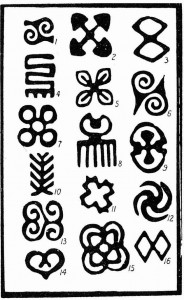
It makes some sense that the Ashanti take the limelight here, they are the largest subgroup of the Akan and thus most Akan that we’ve encountered over the centuries have been Ashanti. But what’s important about it is that details like that lead to us sometimes not understanding the culture as a whole. And so, today, let’s address the larger group’s beliefs (as well as I can in the space I have).
The Akan Religion
One of the most common language groups around the Gulf of Guinea region of West Africa, Akan is the language of several subgroups, the largest of which being the Ashanti. But, as they were united by language, the Akan were also very much united by religion. The religion they had was one that could be considered very familiar to people in the western world. You see, despite our common depiction of African traditions, the Akan were primarily monotheistic with all other entities being classified as animist spirits or ancestors.
The Akan who were forced to take up Christianity thus saw these spirits being very similar to the Catholic idea of Angels and Saints. As such, what we have with the Akan is a religious structure very similar to what they were eventually forced to adopt, but with differences in how they interacted with these higher powers and what they thought of them. Of course, this starts with their depiction of…
God
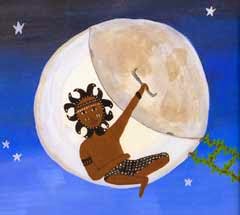
The Akan primarily believe in a single supreme deity which rules over all other spirits and was responsible for the creation of the world. Though there has been some debate as to the existence of other gods, for the most part this is due to the fact that the supreme deity of the Akan religion has many names depending on how the person speaking of him or to him intends to address him. As such, the supreme deity of the Akan has names according to region, function and differences in language.
Among the common names is Brekyirihunuade, the almighty, which is used to refer to the supreme deity’s power. However, while this is the name that he is given to speak of his might, it isn’t the name that is used to refer to him when he is the creator. Instead, as the creator, he has names such as Anase Kokuroku (“the great spider” or “great designer”), Oboadee (“creator”), or Odomankoma (“infinite inventor”) just to name a few. These names do not refer to separate entities or even separate aspects (usually), but rather are descriptive titles much as how a Christian would use “Lord” in a similar fashion for their god.

One of the most frequently used names for the Akan supreme deity, especially among the Ashanti, is Nyame or Onyame. The name Nyame stands for “the one who knows and sees everything”, representing the omniscient nature of the supreme deity. And, in fact, when converted to Christianity, many Ashanti took the name Onyame and applied it to the Judeo-Christian god (adding yet another name to his long list of them). This was an easy transition, all things considered, because there are many similarities between the two deities and how they were perceived. However, that isn’t to say that there are no differences.
One of the primary differences between Nyame and the Christian god is how people interact with him. Many Akan believed their supreme deity was once very close to people, walking among them and interacting with them directly. This interaction was an intentional effort on his part, seeing as Nyame is typically depicted as being too complex or great to be perceived by mortals. However, despite his efforts to interact directly with the people, it is usually said that humanity’s general hostility warded Nyame away and made him decide to become more aloof, ascending to the heavens and restricting his interactions through the natural forces and spirits that serve him on the Earth. Despite this aloof nature however, the Akan believe that Nyame can still be communed with directly by invoking his name.

Because of this direct nature of communication, invoking the name of their god in order to commune with him, another difference is a lack of priests devoted to the supreme deity. The worship of the all knowing, all seeing god is thought to be a natural attribute of life and the use of his name is all that is necessary to reach him. When this happens, however, Nyame does not respond directly, rather sending messengers and lesser spirits in his place. It’s said that Nyame is too great to be interacted with directly in his natural form, so to respond directly would be too much for the people to handle.
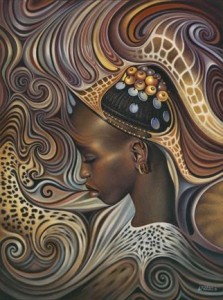
Similar traditions relate to his wife, the fertility goddess Asase Ya. Asase Ya, being a lesser deity but still incredibly powerful, acted as the spirit in charge of fertile lands and was worshipped often by those who would work the fields. There were no temples devoted to her and her worship was handled primarily in the places where her power was needed most. But, like her husband, it was believed that invoking her name was all that was needed to commune with her and ask for her help. Together, Asase Ya and Nyame had two (sometimes three) children.
Nyame’s Sons
The first of these was Bia, the eldest son of Nyame and his favorite. According to some stories, Nyame intended to give Bia control of the most fertile lands of the Ashanti while Bia’s younger brother, Tano, was to be given the barren lands of the Ivory Coast. To deliver this message to his sons, Nyame sent a messenger spirit in the form of a goat and had the goat inform him of his decision. The goat, meeting with Tano and Bia, decided that he preferred Tano and informed the son to meet with his father Nyame earlier in disguise as his brother. Tano took the goat’s advice, disguised himself as Bia, and then went to meet with their father. Nyame was fooled by this disguise (despite being all seeing, because apparently gods can pull that on each other), and granted the fertile lands to Tano instead of Bia, thus, the name of the river to run through the most fertile lands is now the Tano River.
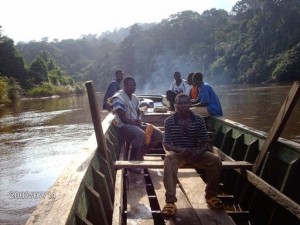
Tano went on to be a much more important spirit after this, being the master of the river which brought water to the fertile lands and also being said to be a protective spirit of the people. Worship of Tano was prevalent in times of strife, due in part to a story relating to Tano’s interactions with Death itself. According to the story, Tano and Death held a competition, attempting to determine who was the better singer and making a wager on the results. When it turned out that neither could cleanly beat the other, the two decided to make a compromise on their wager. As such, it was believed that when Tano went to the human world, Death would come as well. According to this legend, when they arrived in the mortal world they would race each other to the side of someone on the verge of death, the winner claiming that person. As a result, Tano was often seen as the one responsible for someone surviving illness or injury, having defeated death in the race for that time.
The third son’s status as a son varies from story to story, but his name is one of the most well known to the western world…
Anansi the Spider
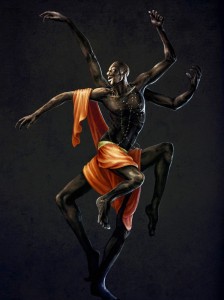
Anansi the spider is probably the most well known aspect of the Ashanti culture. Though not often included into the religious practices and certainly worshipped, Anansi is an important figure in folk tales and oral traditions passed down over time. Anansi holds the role of the trickster folk hero, much like Coyote of the Americas or the Br’er Rabbit of the Bantu (which we’ll get to when we reach central Africa). Anansi is not particularly an object of worship, rather a player in a larger picture. He is often used in a similar fashion to Aesop fables, explaining aspects of the world or giving origins to natural phenomenon with sometimes comical results.
Stories of Anansi range from how spiders got their narrow waist to how wisdom itself was spread through the world. The one commonality between all of these stories is that Anansi is… a bit of a jerk. Like most tricksters, Anansi tries his very best to approach everything clever rather than honest. He often comes about doing the right things for the wrong reasons or completely accidentally. A few times he will actually do the right thing for the right reason, but this is often only after he’s tried to do the wrong thing for as long as possible.
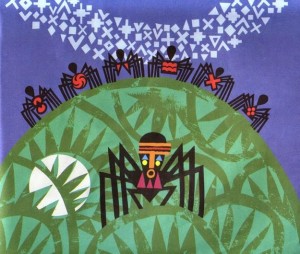
One of the interesting aspects of some of his stories is that Anansi is often used as a means to an end by Nyame himself. Anansi is one of the few beings in the world who can directly interact with Nyame in many stories and will often speak to him either to receive a task or to try to gain favor with Nyame. The most important of these stories revolves around the obtaining of knowledge, wisdom, or the arts. Though, while these are all noble things, Anansi’s reason for trying to obtain them or doing what he is told by Nyame is rarely more than trying to hoard it all for himself. In fact, according to most stories, Anansi holds ownership of all fables told after having obtained them from Nyame, thus the Ashanti word for most of these stories is “Anansesem” – “spider tales”.
In this way, while Anansi is merely a folk-hero, he could best be described as acting as one of the natural forces of the world, a spirit which serves Nyame and provides wisdom to the world (intentionally or not). And this is where the animist nature of the Akan comes in, because while they only really worship Nyame and his family, they believe that Nyame has many servants in the form of spirits known as the…
Abosom
The Abosom, lesser deities and nature spirits which are present throughout nature, are also represented as being children of Nyame (but not necessarily Asase Ya). They act as his agents in the mortal world, operating his creation and managing his interactions with humanity. When Nyame’s name is invoked and he chooses to respond, it is through the Abosom that he will generally respond.
The Abosom can manifest in many forms and are known to come in almost any natural form that is needed for the task at hand. They’ve been represented as having appeared to people as everything from a gentle breeze to an entire mountain and anything in between. Often, they come in the form of animals carrying out the tasks of Nyame much like Anansi or the goat who preferred Tano.
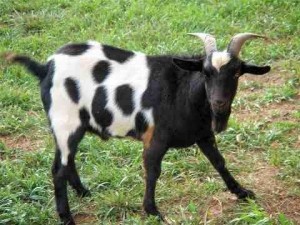
However, none of these is their true form, merely temporary forms as their spirits use these objects as vessels. In truth, their real form is immaterial, an intangible energy. They have no gender and rarely have names. In essence, they are extensions of Nyame’s power, deriving their abilities directly from him and being created by him specifically for the tasks they are given. The chief task given to them as this extension of Nyame is to commune with the human beings who may call out to him. As said before, it is believed that Nyame himself is too great to be able to interact with humanity directly. As such, the Abosom’s primary mission is to be his messengers, much like the Angels of Christian origin.
Stories of the Abosom are much less prevalent than those of the gods or the trickster Anansi, for a few obvious reasons. The first of these reasons is that they are less entities and more aspects of the world. The Abosom may be spirits, but they are generally not part of the world so much as they are passing through it and enacting Nyame’s will. In this way, the Abosom are rarely credited for being responsible for what has happened. The second is, since they are formless, nameless and carrying out interchangeable functions, they tend to be lost in the Oral traditions which change from one story teller to the next in terms of details, morals and method.
In fact, for many of these stories across all of these entities, you will find that the stories themselves are often variable, only the most important details remain the same throughout. Nyame is all knowing and all powerful. Nyame has a family which consists of a wife and sons, and at least one of these sons may be connected to the very forces of life and death. When you speak Nyame’s name, you are communing to him and he may respond to you with an Abosom, which may come to you as something as simple as a breeze. And as for Anansi…
He usually isn’t as clever as he thinks.
(I write books. Sometimes, I write this blog too. I apologize for the delay in the latest Alternative Mythologies entry, but as some of you may know: the blog is named after this season making me terribly sick. So I hope you can understand. However, I intend to update more this week since I’m feeling somewhat better.)


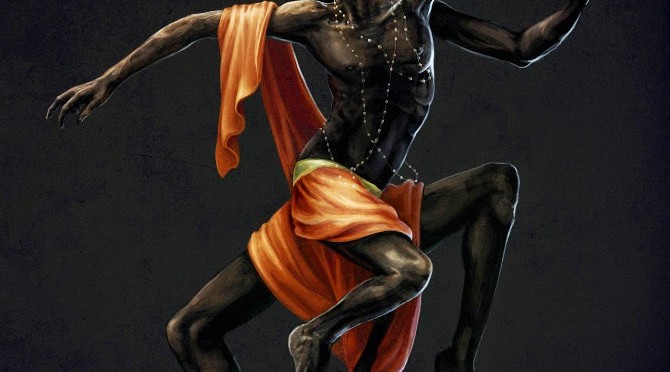
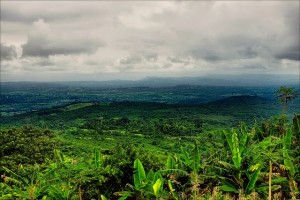





As an Akan, some of the information is off. Some of the things written in here are not true.
Entirely possible that some of my sources were wrong, I try to double check but it’s easy for misinformation to be echoed in other places. If you’d like to point out the errors and a better source I’d be happy to look into it when I get the time and post corrections 🙂